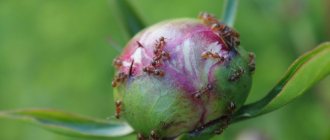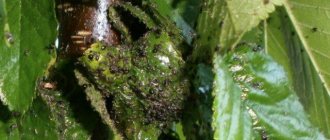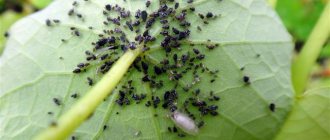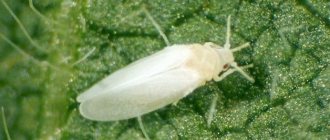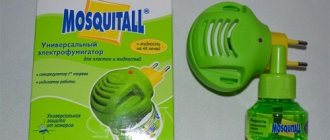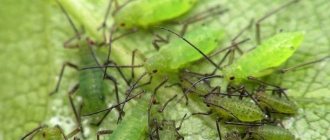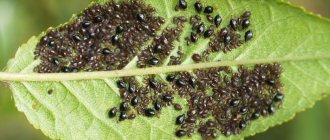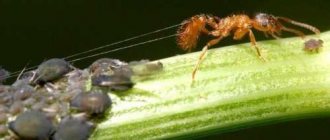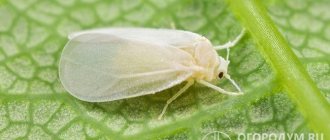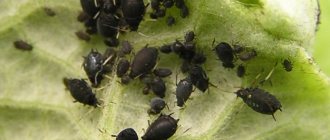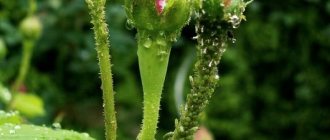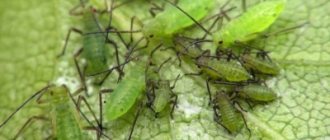Unfortunately, tomatoes grown in beds in open ground and in greenhouses, like many other garden crops, can be attacked by pests. Among them are aphids, which rarely attack tomatoes, but such a pest is still found on their bushes. Aphids on tomatoes can harm plants, so when they appear, you need to get rid of them immediately. Let's consider what you can spray with tomato seedlings and adult bushes and how to prevent the appearance and reproduction of the pest.
General information about the pest
Aphids are a dangerous pest on tomatoes. It refers to:
- class - insects;
- order - homoptera;
- family - true aphids.
There are more than 3,000 thousand of all types of aphids. They are migratory, which feed on several plants, and non-migratory, living on one.
The insect, depending on the species, can be all shades of green to light brown. The body is spindle-shaped. The magnitude also depends on the type. Potato aphids, for example, up to 4 mm.
Aphids are polyphagous; they can use any vegetation for their nutrition.
Aphids are cosmopolitan. It is distributed throughout the globe.
The aphid's mouthparts consist of a proboscis. The insect uses it to pierce the integumentary tissue of the plant and suck out the tissue fluid.
Aphids reproduce sexually and asexually. In autumn, the female lays an egg. It is round, oval or slightly elongated. The egg spends the winter on the main plant. Next, the “founder” hatches. It has no wings and therefore continues to live on the same plant and produces up to 50 larvae. From them grows a “wingless virgin,” who gives birth to a “winged settler.” They are the ones who move to tomatoes and reproduce asexually there. A small number of fruit-bearing females appear among the population. By autumn they return to the main plant and lay eggs. The life cycle has ended.
The air temperature is very important for the development of the insect. So at optimal temperature the larva develops in 6 days, and at 10ᵒC - 21 days. Worsening weather and colder temperatures delay development and thus significantly reduce the insect population.
How to identify a pest
What a tomato affected by aphids looks like can be clearly seen in the photo. Insects usually live in colonies, especially wingless virgins that cannot fly, which are “herded” by ants. They completely adhere to the top of the tomato and the adjacent young vegetative organs.
Winged females can settle on the underside of leaves. With severe damage, the lower part of the plate is completely covered with green or black pests.
Other signs of aphid infestation of tomatoes:
- vegetative organs are covered with sticky sweet honeydew;
- leaves curl, flowers are deformed, buds do not open;
- tomatoes look depressed;
- with severe damage, the aphid drinks all the juice from the vegetative organs, and they dry out.
The pest does not touch already set fruits. He simply cannot bite through the thick skin.
Description of species
The following can live on tomato bushes:
- peach or greenhouse aphid;
- potato large aphid;
- melon aphid.
Peach aphid
It is this species that can infect tomatoes in a greenhouse. It is characterized by the following indicators:
- optimal development temperature is 24ᵒC;
- minimum temperature (below which the pest does not feed) - 10 ᵒC;
- fertility - 5-10 eggs;
- generations per season - from 4 to 15;
- the threshold of harmfulness is the colonization of 26% of the leaves of the plant.
The melon aphid has:
- optimal development temperature -15 ᵒC;
- fertility - up to 40 eggs;
- generations - 20.
The parasite of tomatoes is the migrating aphid, but the tomato is in the background for it. Not a single insect chose the tomato as its favorite type of food. If we take, for example, the peach aphid, then the eggs and two generations degenerate on the tree and only in the summer does the “winged disperser” move to the tomato plantings. By autumn, the winged forms return to the peach and lay eggs.
The large potato aphid has chosen potatoes, but tomatoes can also be its temporary home. She overwinters in the wingless virgin stage. In the north in warm rooms, and in the south directly on weeds in open ground.
Knowing the morphology of the insect, you can plan tomato planting in such a way as to prevent the appearance of aphids.
Why are aphids dangerous?
Tomatoes can be infested by several varieties of aphids, each of which has its own characteristics. The main pests of tomato plants include:
- White or root - this insect can be identified by the pear-shaped body of a pinkish or golden brown color. White aphids live in the upper layers of the soil, so identifying the pest in the area is very difficult. This insect is extremely active and affects large areas of the garden.
- Melon - this type of aphid has microscopic body sizes, not exceeding 1.5-2 mm and a black or green color. It affects beds both in greenhouses and in open ground.
- Peach aphid - This aphid is also called greenhouse or tobacco aphid. Most often it overwinters on peach trees; in the summer it actively attacks tomato beds.
- Potato insects are large insects with a body of about 3-4 mm, light green or reddish in color. They feed on tomato bushes in greenhouses and gardens.
White aphids feed on the root part of tomato plants, which leads to disruption of nutrition and oxygen supply to the root system. As a result, the bush begins to wither, lag in growth and quickly fade. White aphids lay eggs in the upper layers of the soil, where they tolerate winter frosts well, and in the spring they emerge to the soil surface.
Melon and potato aphids cause no less harm to tomatoes. They actively feed on tomato bushes, disrupting the metabolic processes inside the plant and leading to its wilting. Tobacco aphids are the least likely to be seen in garden beds; most often they live near peach trees, overwintering on their crown and foliage.
Signs of appearance and damage caused
Initially, the vegetable grower may not notice the aphids. It is placed at the bottom of the leaf blade, along the veins. Over time, its population increases.
Attention should be paid to leaves and shoots. Then the aphids move onto the flower stalks. Here it already becomes visible even without special examination. The plant begins to lose color and the leaves curl. The bush will become covered with sticky sweetness and this will attract ants who hunt for it.
Having settled on a tomato, the aphid sucks out the cell sap. It would seem that one small insect will not cause harm. However, aphids carry up to 50 phytoviruses. Although not all of them cause harm to tomatoes, this possibility should not be missed.
Tips and tricks
The following recommendations will help you effectively exterminate pests without harming beneficial insects:
- If you decide to chemically treat plants, do it in the evening. This way you won't harm pollinating insects.
- Once aphids appear, treatment must be carried out throughout the season. If you relax, all your efforts in May may become fruitless in July. Processing can include all available methods: from folk to chemical.
- Among the specific treatment methods used are spraying bushes with Coca-Cola. Experienced gardeners claim that this remedy is effective. Keep the bottle of Coca-Cola open until the gases dissipate, then add a little liquid soap or dishwashing detergent to help the drink linger on the leaves longer. Put on the sprayer and get to work. To prevent Cola from baking in the sun and harming the leaves, it is better to spray it in the evening.
Symptoms of aphids
A healthy tomato plant is not suspicious. However, aphids may already be living on it. If it is not detected in time then:
- the leaves will curl, wrinkle, turn pale;
- flower brushes will be covered with insects;
- the buds will turn yellow and fall off;
- young shoots will stop growing;
- the ovary will not form.
A heavily damaged plant will be visible from a distance. An unhealthy appearance of a tomato bush and the presence of a parasite will indicate that the process has long been started and the aphids have been feeding on tomato bushes for at least 15-20 days.
Mistakes of beginner gardeners
Inexperienced gardeners often do not pay attention to signals that there are aphids in the area, and therefore precious time for a quick response is lost, and the pests make their home in the garden.
Signs that precede an aphid invasion:
- Ant activity. Ants are friends of aphids, so if you notice the movement of ants in the beds, it means that aphids will soon appear on the seedlings. What to do? Fight ants.
- Several pests on the branches. This is a signal that they will attract hordes of aphids in a short period of time. Immediately start spraying the plants with what you have at hand: soap solution or ash.
- Rarely weeding the beds. Frequent loosening of the soil is the key to good air circulation between tomato bushes, which is beneficial for plant health. If you grow crops in greenhouses, do not forget to ventilate them more often.
Inspection of plants should be done several times a week, looking under the leaves of the plantings, because this is a favorite breeding place for aphids. The faster you react and apply one of the methods described above, the more effective the measures to destroy aphids will be.
How and with what help to fight aphids on tomatoes
Aphids are aggressive insects due to their fertility, however, if you notice the pest in time, you can easily deal with it.
Mechanical methods of struggle
The mechanical method can only be used if there are few tomato bushes. After looking through all the leaves and shoots, you can remove the aphids with your hands and lightly press them.
If spruce plantings are extensive, it is not advisable to use mechanical methods.
Chemicals
Modern industry produces effective and low-toxic preparations for warm-blooded animals against aphids on tomatoes.
- Aktara. The insect has no habit. The aphid dies within 20-24 hours. Compatible with fungicides, which is very important in mid and late summer, as late blight begins to rage;
- Angio. Systemic contact insecticide. Works at any temperature and humidity. The active substance accumulates in young shoots;
- Fufanon. Organophosphate insecticide. Not compatible with any plant protection products. Suitable for use at high temperatures. Decomposes quickly. The insect dies within 1-2 hours;
- Biotlin. Contact-intestinal insecticide. The active ingredient is imidocloprid. Insects die after 2-3 hours. Protection lasts 15-20 days.
When using chemicals, you need to pay attention to the waiting period from the moment of processing the plant until the moment of harvesting.
Biological drugs
Fitoverm is recognized as the best biological preparation. The product is created on the basis of waste products of soil microorganisms. Fitoverm:
- is not addictive;
- does not accumulate in fruits;
- low waiting period - 1-3 days;
- Can be used at any time of the growing season.
The disadvantage is that the drug decomposes quickly and requires several treatments. The period of protective action is 5-7 days.
Attracting Natural Enemies
Aphids, like all insects, have their enemies. They feed with pleasure:
- rider Aphelinus;
- ladybug;
- oviparous thrips;
- camels;
- praying mantises.
Large industrial farms can afford to purchase entomophagous insects and release them into tomato plantations and greenhouses. For an amateur vegetable grower, this method is not yet profitable.
Plant repellents
Theoretically, it is believed that there are aphid repellent plants, which, when planted next to tomato beds, will not attack the insect.
Such aromatic crops include:
- calendula;
- marigold;
- basil.
These are annual plants and should be sown annually along tomato plots.
Among perennials, rumor goes about tarragon and hyssop.
All of these plants are wonderful in the garden, flower garden and on the kitchen table, but they do not repel aphids.
Folk remedies
Aphids have existed since ancient times. People had to fight it long before the advent of chemical and biological plant protection products. Through trial and error, we managed to find products that are successfully used against aphids on tomatoes.
Ammonia
The fight against aphids on tomatoes is possible using the pharmaceutical preparation ammonia solution 10%. Take 40 ml of ammonia into a bucket of water, dissolve it and immediately spray it. The repeat is carried out after 10 days.
Soap
Alkali has a detrimental effect on the delicate body of the insect. A piece of laundry soap weighing 20 g is crushed and filled with 1 liter of water. Leave until completely dissolved. Strain and spray.
Garlic
Garlic phytoncides are quite strong and have proven themselves as a treatment for aphids in tomatoes.
For preparation take:
- peeled and chopped garlic cloves - 30 g;
- water - 1 l.
Infusion time is 24 hours. Strain and spray the tomatoes.
Soda
Baking soda is also alkali. Its solution is harmful to insects. To prepare, take 2 tbsp per bucket of water. spoons of soda.
Celandine
People have long been using celandine infusion against aphids on tomatoes. However, it does not work on its own, without soap. The main active ingredient is alkali.
Onion peel
Nasti and onion peel decoctions do not affect aphids.
Tobacco
Tobacco dust 500 g is poured with a liter of boiling water and left to cool. Next, the mixture is diluted in a bucket of water.
Marigold
Wonderful flowers, but they don’t work against insects.
Citrus peels
Aphids do not like the smell of citrus fruits. But, a decoction or infusion of citrus peels is harmless to aphids and the remedy does not work.
Flower infusions
Unfortunately, there are no flowers that can successfully fight aphids on tomatoes.
Essential oils against aphids
Essential oils are used against aphids as repellents. However, in the garden, on tomato plantings, the product is not effective.
Recipes for dry powders against aphids
Experienced gardeners recommend using stove ash at the first sign of aphids on tomatoes. The method works, but there are several nuances that should be considered:
- the ash must be dry;
- Tomato bushes should be moist. It is more expedient to carry out sprinkling on dew;
- the ash is first sifted through a fine sieve;
- Ash can only be used after burning wood.
To treat plants, it is enough to sprinkle the bushes with stove early in the morning. The base of the drug is alkali. For tomatoes, ash works as a fertilizer and at the same time kills aphids.
Recipes for water infusions against aphids
You can successfully use:
- infusion of yarrow. To prepare, collect inflorescences and pour 1 liter of boiling water into 100 g of plant material. Leave until completely cooled. Strain and process the tomatoes;
- mustard infusion. 1 tablespoon of mustard powder is poured into 1 liter of boiling water and left to cool. Dilute with 1 liter of water and spray the tomatoes.
Alcohol preparations for controlling aphids on tomatoes
Inventive people dissolve 1 glass of vodka in a liter of water and add 40 g of soap. Tomatoes are treated with this solution. Works. However, this remedy will work without vodka.
Recipe based on tomato leaves
In pursuit of naturalness, people try everything. Recipes for infusions and decoctions based on tomato leaves for aphids contain alkalis. Soap and baking soda work against aphids, but a decoction of tomato leaves alone does not work.
What are aphids?
This small pest belongs to the insect kingdom, the suborder Hemiptera. A distinctive feature is a specially designed oral apparatus, which is a piercing-sucking proboscis.
In total, there are about 4,000 species of these insects in the world. They can be winged or wingless, capable of same-sex reproduction and so-called viral reproduction on the body of the “host”.
Harm of aphids to plants
The aphid feeds on the sap of the plant, digging deeply into its “body” with its proboscis. Insects not only suck out the sap, settling on leaves and stems in whole colonies, but also carry viruses. At the sites of their settlements, fungal formations arise that are destructive for garden and vegetable crops.
Over the summer, the insect leaves behind three generations of larvae, which do nothing but “milk” the plants. Having sucked the juice from one, they move on to the next, so if timely measures are not taken, aphids can ruin the entire harvest.
Signs of defeat
Insects do not really like the fragrant greens of tomatoes, but they can also attack them if there is a lack of nutrition for their offspring. Black, white, tomato, and melon aphids grow on tomatoes. You can understand that a crop is infected by external signs.
Since colonies of insects cling to the entire lower part of the leaves, soon their edges begin to deform, curl, and wither. If the plant is affected, black and white aphids will be visible on the stems as a black or powdery coating.
Another indicator of the presence of aphids is sticky shiny spots on leaves and fruits. This is the so-called honeydew - a sweetish liquid secreted by aphids. It falls from the bottom of the leaf to its front side or fruit and is baked in the sun. Ants, constant allies of aphids, greatly value such a high-calorie product. They tickle the aphids with their paws, and they give them a drop of their sweetness. Ants look after their nurses, so they often carry them from one plant to another.
If you see such signs in the beds, this is a signal that you need to save the plants.
The best products for greenhouses
Experienced farmers have come to the conclusion that the drug Enzhio best fights aphids in greenhouses.
The greenhouse has high temperature and humidity, especially if it is an amateur building and the microclimate is not regulated. Engio is effective in such conditions.
The solution is prepared at the rate of 3.6 ml per 5 liters of water. The active ingredient thiometaxam enters all cells of the tomato plant within an hour. The aphid dies immediately upon first attempts to feed.
The drug is retained in the sprouts for 20 days creating protection.
Biotlin also does the job well.
For open ground
In open ground, to combat aphids on tomatoes, it is better to use the drug Aktara. You can add fertilizer or a fungicidal preparation to its solutions and the effect will be enhanced.
What harm does an insect cause to tomatoes?
Aphids are sucking pests that feed on plant juices. If you don't fight it, it completely depletes the plant and destroys it.
The parasite is also dangerous because it transmits viral and fungal diseases. Infection occurs through the proboscis, with which the insect sucks out the juice. The pest carries diseases such as tomato mosaic, late blight, and powdery mildew.
As the colony grows, the leaves of the plant become deformed and dry out. If the tomatoes are already ripe, aphids will not cause them any harm. If not, the fruits stop growing and take on an irregular shape because they lack nutrition.
Prevention measures
If the tomato bed is properly laid out and the seedlings are clean, aphids will not appear on the tomatoes.
For this:
- Before planting, carefully inspect the tomato seedlings. For 100% effect, dip the roots of the seedlings in a solution of the Enzhio preparation;
- We plan planting so that the predecessor is not nightshade crops. This is especially true for the southern regions;
- a tomato bed cannot be arranged next to a potato bed;
- After harvesting potatoes and tomatoes, carefully remove all plant residues and send them to a compost bio pit or burn them.
The main preventive measure is daily careful inspection of tomato plants. When aphids are first detected, they are immediately treated with effective drugs.
Description and life cycle of the insect
Aphids belong to the group of Coleopteran insects. The size varies from two to seven millimeters. These parasites have a proboscis that pierces leaves and stems. They feed on plant sap and secrete a sweet-tasting liquid that attracts ants. Individuals of all varieties are either winged or winged.
Pest varieties
Black, green, white, red and melon aphids are found in garden plots. The following types of pests are most often found on ripe tomatoes and tomato seedlings:
- brown or white. Their larvae overwinter in the soil. The parasites are mobile and can quickly chew through the stems. Having settled on seedlings, they block the shoots’ access to moisture and suppress the growth of bushes;
- potato It is green or red in color and reaches up to four millimeters in size;
- melon One of the smallest varieties of pest. Their size does not exceed two millimeters. Parasites are green in various shades;
- peach The larvae are found in the buds of peach trees in winter, and in spring they begin to actively reproduce and infect all kinds of garden plants.
Timing of appearance and reproduction
Parasites appear in the spring from larvae that hatch from eggs laid in the fall. When they finish molting, pests begin to actively reproduce. At the same time, wingless females are born.
Reviews
Antonina Dmitrievna
City - Vologda
For me, aphids are a scourge. She's everywhere. Trees, bushes, roses and now tomatoes. We recommended Biotlin. I bought it because it wasn't expensive. Very satisfied, effective product. But, strangely, she still appeared. It turns out that you have to treat it 3-4 times per season; it’s a very dangerous pest.
Sergey
City — Smolensk region
I don’t understand why aphids are such a problem. It can be easily removed with a solution of laundry soap. The main thing in this matter is the multiplicity. For example, I spray everything at once every 1st and 20th. I made the solution, filled the sprayer, walked along the young shoots of the vegetable garden, and there were no problems. I recommend to everyone.
Vasily Pavlovich
Yekaterinburg city
For a long time I could not solve the problem with aphids in the greenhouse. Then I decided to leave it empty for one year, but to my surprise it did not solve the problem. I used the drug Bitlin from August. A good remedy, it helped, but by the fall it needed to be processed again, and the crop was already turning red. I had to use home remedies. I tried a lot, but simple soap was enough. I plan it and fill it with water by eye, so that the foam is stable. I process it several times, but there are much fewer insects.
Sonya
Samara city
I am a supporter of organic farming. In the fight against aphids, Fitoverm is the most effective and reliable drug. Non-toxic and natural. I spray it all over my garden, garden, and flower garden. I often run around with a spray bottle, but the insects have forgotten their way to me. I highly recommend it, especially for those who cannot tolerate chemicals.
Types of aphids that live on tomatoes
There are a huge variety of pest species. Aphids are classified according to size, color, and some developmental features. All varieties of the parasite multiply quickly and occupy large areas in a short time.
The following types of aphids are dangerous for tomatoes:
- black;
- white;
- peach;
- melon
Regardless of the type, the pest causes significant damage to plantings in the garden. Aphids do not touch the fruits, but kill the plant itself. Insects prefer young greenery.
Traditional methods of fighting aphids
As already mentioned, in the initial stages of infection by harmful insects, folk remedies will be of great help. Here are some of them:
- Tomatoes must be sprinkled several times with a prepared solution of 400 g of vegetable oil, with the addition of two tablespoons of soap (this mixture is calculated in proportions to one liter of water).
- Various herbal infusions work well against aphids. You can use herbs such as wormwood, celandine, yarrow and any other plants whose taste is bitter and whose smell is strong and pungent. For a liter of prepared tincture, you need to use about 40 grams of any soap, this will help the infusion stick more strongly to the plant.
- You can also use a solution prepared from ash: add about 10 grams of ash and 20 grams of soap to 10 liters of water.
- It's no secret that soda is effective in, perhaps, any area. And even in the fight against aphids it can be effective. It is enough to add about 80 grams of soda to a bucket of water. This solution can be used to treat not only tomato bushes, but also fruit trees.
- Ammonia can help fight aphids; it acts as a poison for insects, affecting their digestive organs, causing them to die. In order to prepare such a solution, you need to add two tablespoons of ammonia and one tablespoon of soap to a bucket of water.
The treatment should be carried out at sunset on a windless day. Please also keep in mind that after rain, the aphid repellent will be washed off and you will have to apply the treatment again.
Do you still have any questions? Then we recommend that you watch this video:
Ways to fight
There are many effective methods to combat the scourge. Most of them lead to the complete destruction of insects. There are three main ones:
- Physical is the most labor-intensive method, which involves visual inspection of every millimeter of the plant and manual removal of larvae and eggs. You can use a hose to irrigate tomatoes; larvae and insects are simply washed off the bushes under running water.
- Chemical – the method is based on a chemical effect on parasites, leading to their complete extermination. Insecticides are most often used, but they can be replaced with folk remedies. The composition contains toxic substances that cause the death of insects.
- The biological method involves the creation of natural selection. They attract birds to the garden and eat aphids. Ladybugs help eradicate parasites; they are introduced into the area and left to reproduce.
Chemicals
Substances with an active chemical effect include Karbofos. It is an emulsion with a specific odor, which is diluted with water in a proportion of 30 grams of the drug per 10 liters of water. Water the soil with the solution in the morning, then repeat the treatment a week later. It is better to use the product before flowering, as it can subsequently have a toxic effect on the fruits.
Another chemical used to control aphids is bleach. Prepare a working solution:
- 2 tbsp. bleach powder;
- 10 liters of water.
Apply to affected shoots and leaves. Spraying should start from the lower shoots and then go up. You can water the soil near the bushes with the mixture, the effect will only increase. It is advisable to use bleach before the formation of ovaries.
Other insecticides should be used in accordance with the instructions on the package. Dilution of the substance is carried out using gloves to avoid chemical burns or an allergic skin reaction.
Important!
All insecticide treatments are carried out no more than 2-3 times.
Preventive measures against the appearance of aphids
To avoid the appearance of parasites on the site, the following preventive measures are used:
- Regular inspection of plant stems and leaves. Try to destroy insects when they first appear, otherwise they will spread to other crops.
- Ventilation of greenhouses and greenhouses.
- Maintaining optimal air temperature and humidity in the greenhouse.
- Fighting ants. They are the ones who bring aphids to garden plots and breed them.
- Planting crops that repel aphids next to tomato beds. These are carrots, dill, parsley, onions, garlic, lavender and thyme.
- Digging and liming the soil in the fall. Lime kills aphid eggs.
- Removing and burning plant residues on the site.
- Sterilization of garden tools after each season.
Why do aphids appear?
These insects feed from succulent plants, so tomatoes with their amount of liquid and pulp are attractive to them. Other reasons for their appearance:
- mistakes were made when cultivating the land;
- insufficient number of insects or birds that eat aphids;
- a large number of garden ants, which contribute to the reproduction of aphids;
- infected plants;
- weather;
- poor quality land.
Important! When the first signs appear, it is necessary to begin pest control, since they lay a large number of eggs and spread very quickly!
